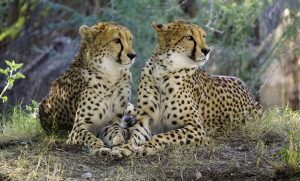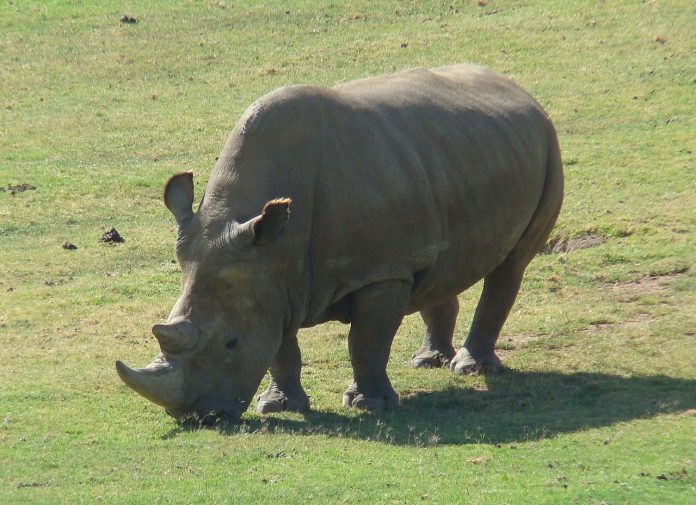News sites have been doing good business this month with the excellent announcement from Kenya that eggs from the two last remaining northern white rhinos have been successfully fertilized artificially, reviving hopes of saving the endangered animals after the death of the last male named Sudan last year.
It’s a landmark announcement that offers a glimmer of hope that the animal might be saved from extinction by human ingenuity.
The eggs were harvested from Najin and Fatu who are Sudan’s daughter and grand-daughter and who, until Sudan’s death at the age of 45, lived with him at the Ol Pejeta Conservancy, about 250km north of Nairobi.
Scientists from the Leibniz Institute for Zoo and Wildlife Research in Berlin announced they had successfully harvested 10 eggs and that seven of those had been matured and artificially inseminated with sperm from two bulls of the same species, which had previously been frozen.
“This is the next critical step in hopefully creating viable embryos that can be frozen and then later on transferred to southern white rhino surrogate mothers,” the scientists said.
The success of this particular endeavour has given new hope to conservationists around the world who have, since the 1970s been harvesting sperm and ovum from endangered animals in the hope that they may be brought back one day.
The hope back then was that wild animals, much like horses or cows, could be repeatedly artificially inseminated to bring numbers up, or improve the diversity of genes, but the reality since then has been almost devastating in its failure. The truth, scientists have subsequently discovered, is that not all animals work the same way and that our ability to artificially create horses, dogs, and other domesticated animals is a product of millennia trial and error, and billions of rands of research.
“Black-footed ferrets and giant pandas are the only endangered species routinely produced through a combination of breeding the old-fashioned way and artificial insemination,” Pierre Comizzoli, a research biologist and project leader of the Pan-Smithsonian Cryo-Initiative in Washington, D.C.
Increasing successes

While Comizzoli is correct there have been some, if not regular, successful attempts with other animals such as elephants, chimpanzees, lions, gorillas, the white-naped crane and now, hopefully, the northern white rhino. Efforts are also ongoing to artificially inseminate cheetahs whose naturally genetic diversity is a critical threat to their ongoing survival.
While it all sounds relatively simple, introduce the sperm of one male, with the eggs of one female, researchers have found numerous unexpected stumbling blocks along the way. The first challenge was simply in being able to understand an animal’s reproductive cycle.
“Depending on the species, males and females can’t breed or produce sperm year-round,” explains Comizzoli adding that understanding this pattern is vital for harvesting active sperm.
“Once they have that figured out, scientists need to find the right mix of hormones to give to the females so that they’re receptive to the sperm. Then researchers must determine where in the female’s reproductive system to place the semen so that there is a good chance she’ll become pregnant,” he adds.
Cheetahs are a great example of just how hard this can be. Adrienne Crosier, who’s been studying cheetah reproduction at the National Zoo for more than a decade explains that this is because cheetahs don’t generally produce good quality sperm samples.
“A lot of cells in fresh ejaculate are motile and of good quality,” Crosier says, but what samples scientists can get from the small cheetah population are plagued by low sperm count and abnormally shaped cells. Mostly, that’s because cheetahs have an unusual lack of genetic diversity, thanks to a population bottleneck 10,000 years ago.”
Making this even more complex is the fact that female cheetahs have extremely irregular oestrus cycles so scientists are forced to administer hormones to reset them. Crosier explains that even then the team has to rely on male cheetahs to let them know when the females are in heat as it is otherwise impossible to tell.
Problems with freezing

Adding even more complexity to the problem is the fact that the sperm samples of some animals have to be frozen to be transported to labs where they can be worked on. For some of the rarer animals, they may have been frozen for decades. Freezing and unfreezing samples is not something that can be done entirely damage-free.
One of the main reasons the Panda is one of the animals humans have been able to successfully inseminate is due to the fact that their sperm is resistant to cold, not fragile, and relatively easy to freeze and reanimate. The flip side is elephants for whom scientists are still struggling to freeze and thaw sperm without it dying.
Despite all this, there is light at the end of the tunnel. Thomas Hildebrandt, who heads the reproduction management program for Berlin’s Leibniz Institute for Zoo and Wildlife Research, and whose team recently made the announcement regarding the northern white rhino is a leading figure in the artificial insemination of animals, having helped conceive upwards of 50 endangered elephant calves by artificially inseminating their mothers.
Hildebrandt is aware that his success with the seven artificially fertilised rhino eggs will likely not be enough to achieve the genetic diversity required to create a sustainable long-term population but hopes his successes will inspire philanthropists and governments to work with teams like his to revive dying animal populations, perhaps through stem cell research or “techniques we haven’t even dreamed of yet”.


